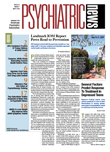Only 1 in 10 callers posing as patients just released from hospital emergency departments and diagnosed with acute depression could get appointments for community-based follow-up care, regardless of insurance status.
“Our results would suggest that, for patients who are already not engaged with a mental health provider, 'usual care' after an ED [emergency department] visit for depression involves leaving a message on an answering machine,” wrote Karin Rhodes, M.D., M.S., and colleagues in the March Annals of Emergency Medicine. Rhodes is director of the Division of Emergency Care Policy and Research in the Department of Emergency Medicine at the University of Pennsylvania School of Social Policy and Practice.
“As emergency department physicians, we spend a lot of time trying to overcome stigma and get patients to talk about their psychiatric symptoms, but it all goes for naught if they can't get into follow-up care,” said Rhodes in an interview.
Patients often take the blame for not following up on treatment recommendations. This may be especially true for depressed patients, who have low energy levels and feelings of hopelessness. But the study indicates“ that even the most motivated patients will have difficulty obtaining timely appointments and pursuing treatment for mental health complaints.”
The researchers adopted a technique widely used to document discrimination in employment or housing. They trained graduate students to pose as patients who had just been diagnosed in hospital emergency departments with acute depression and who were seeking to obtain an appointment with a mental health professional within 14 days. They obtained mental health clinic names and numbers from referral lists used by hospital emergency departments.
The callers sampled 322 clinics in eight major cities around the country in 2002 and 2003, calling each an average of three times. The time limit set by the study in which to obtain an apointment was 14 days. Results were compared with those from a related study of mock patients seeking care for physical health conditions (like pneumonia, hypertension, or possible ectopic pregnancy). The differences between the two arms of the study were striking.
Thirty-one percent of the callers seeking an appointment for depression care managed to connect with appropriate health personnel versus 78 percent of those who called with the physical health diagnoses. Many did not get that far. Forty-five pecent of the depression callers had to leave a message, compared with 8 percent of physical health callers. Response rates were so low in the depression group that follow-up calls intended to measure access by insurance status were statistically inconclusive.
Furthermore, callers who had to leave a voicemail message the first time around had to do so on 80 percent of follow-up calls as well, even when calls were made at different times and on different days of the week. Depression callers also had to make an average of three calls to get a response, compared with 1.9 calls for other medical complaints, and 15 percent had to make at least five calls before speaking to a clinic staff person.
Only 10 percent of the depressed callers were able to make an appointment within the study's 14-day limit. Going outside that limit, 17 percent of the depressed callers managed to get an appointment, compared with 54 percent of the physical health callers.
Time to appointment, once scheduled, averaged 7.6 days for mental health callers, compared with 5.0 days for physical health callers, a nonsignificant difference.
Although data were collected six years ago, Rhodes said more recent studies indicated that these barriers to care were unchanged.
“This is both a capacity issue and a systems issue, and it should be addressed by changes in the system,” said Rhodes. “I hope that part of the effort to reform the health care system includes changes in mental health care on a population basis.”
She noted that patients were more likely to keep appointments if they were made by someone else. Perhaps doctors or other ED personnel might have more clout in breaking through the voicemail barrier to connect with clinic schedulers, she said.
Meantime, the present situation is Kafkaesque, said Rhodes. “You have people finally calling for help and getting an answering machine.”
